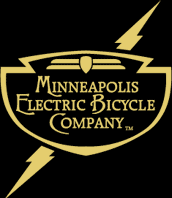Electric Bicycle Factoids
-There are two types of assist featured on electric bicycles- pedal assist, and power-on-demand. Bicycles from the Minneapolis Electric Bicycle Company are equipped with both.
-The popularity of electric bicycles in China was in part fueled by the SARS outbreak, when the population was reluctant to ride public transportation due to risk of exposure.
-The heart of an electric bicycle is the battery technology. Modern lithium-ion technology will ensure a longer life and better performance.
-An electric bicycle offers the same health benefits as traditional cycling, only it allows the rider to choose the level of exertion.

Frequently Asked Questions
How fast does it go?
In places where laws governing electrical bicycles have been implemented, the bike may go no faster than 20 mph under motor power in order to be considered an "electric bicycle" or an "electric assisted" bicycle and thus granted access to federally-funded bike lanes and pathways. Our electric bicycles are designed to comply with these laws, and thus will not exceed that speed without pedaling. However, there's nothing to prevent you from pedaling faster than that.
How far does it go?
The answer to this question will vary depending riding technique, terrain, winds, etc. Under optimal conditions one can travel approximately 40 miles on a single charge.
Do I have to pedal?
No. The Pedal Assist System requires that the cranks be turned once to activate the motor, but after that the motor will propel the bike under throttle control- called Power On Demand. It should be noted, however, that reliance solely on the electric motor is improper technique and will drastically reduce the range. Light pedaling will increase the range and reduce wear on the bike's components with little effort.
Does it charge the battery when you pedal? Does it have regenerative braking?
Short answer: No. It's our goal to make these bikes affordable and efficient, and adding these features would add expense and complexity for very little return in electricity generated.
Can I ride in the rain?
Yes. All components are all water-resistant, and suitable for riding in rain and snow. However, the bicycle's motor and controller should never be submerged completely.
Can I convert my own bicycle to electric?
Yes. Conversion kits are available that will fit most existing bicycle frames. However, there are several disadvantages to this approach.
The first is that they're expensive. If you search out a conversion kit that has the same specifications as those included in our electric bicycles- a 36 volt LiFePo4 battery and 250 watt (400 peak) brushless hub motor- if you can find one, it will likely cost you as much or more than one of our bicycles.
The second is that much thought has gone into the design of our bicycles to provide the tolerances necessary for electric assist. Not all bicycle frames will lend themselves to conversion. It is not recommended that conversions be made by those unfamiliar with electronics and bicycle mechanics.
Lastly, a bicycle made electric by means of a conversion kit must accommodate both the battery and the controller. Often this is accomplished by fixing them to a rack above the rear wheel. The advantage our bikes have over this scheme is that the battery and controller are integrated into the frame, centering the weight distribution, and locked in position to prevent theft. Without this feature, one must take the battery and controller along when leaving the bicycle unattended.